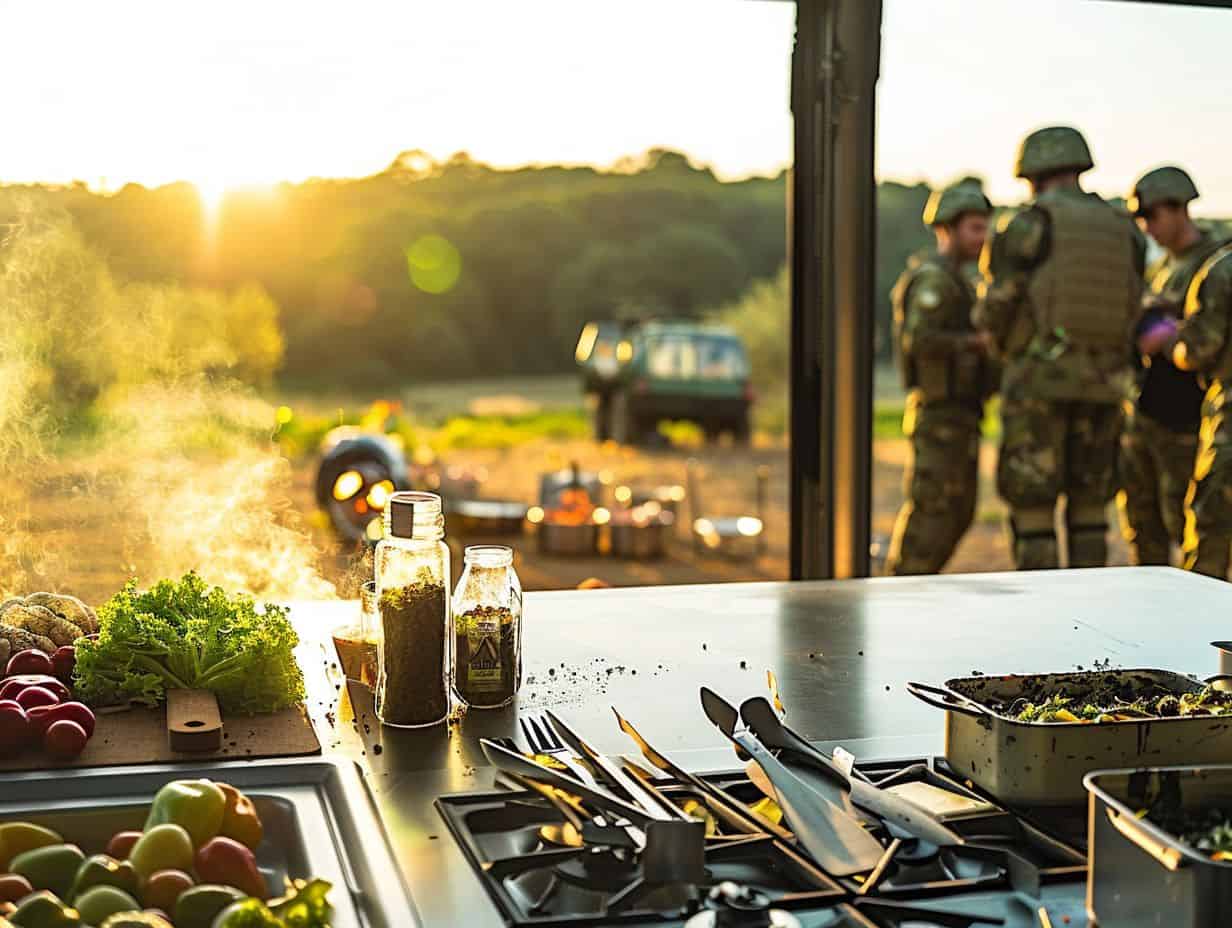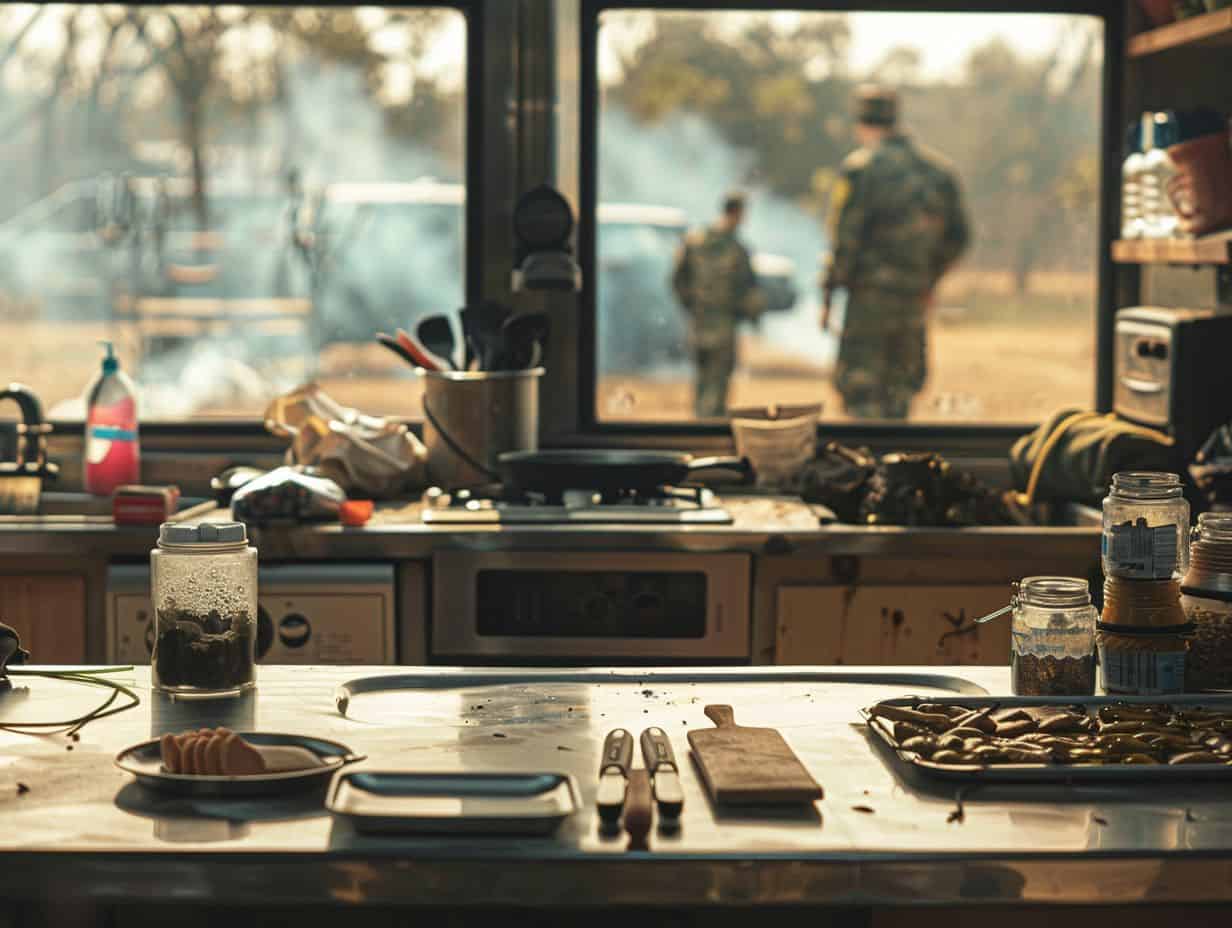Explore the world of MREs – Meals Ready to Eat with an in-depth look at their components, nutritional requirements, and manufacturing process.
Gain insights into the various types of MREs, quality assurance testing, manufacturing challenges, and innovations in taste, variety, and packaging.
Dive into the intricacies of MRE manufacturing processes.
What are MREs?
MREs, or Meals Ready-to-Eat, are self-contained, individual field rations commonly utilized by military personnel during field operations and combat scenarios. These ready-to-eat meals offer convenient and portable food options for troops in the field.
They play a crucial role in ensuring that soldiers have access to nutrition while on the move or in situations where traditional cooking facilities are unavailable. In intense combat environments or during extended missions, the quick and easy availability of nourishing meals can significantly impact maintaining the physical and mental stamina of the troops. The design of Military Rations allows for long shelf life and minimal preparation, making them well-suited for situations with limited time and resources.
How are MREs Used?
MREs are a critical component of military food supply chains, ensuring that soldiers have access to nutritious meals even in remote or challenging environments. These ready-to-eat meals are essential for military deployment, field exercises, and combat operations.
The portability and extended shelf life of MREs make them well-suited for sustaining soldiers during prolonged operations, providing a convenient and effective solution for meeting their nutritional requirements. The range of meal options available in MREs helps to boost troop morale by offering familiar and comforting food choices, enhancing their overall well-being in demanding situations.
From arid deserts to dense jungles, MREs serve as a dependable source of sustenance for military personnel, enabling them to remain focused and energized during critical missions.
What are the Main Components of MREs?
The main components of MREs include a variety of ingredients carefully selected for their nutritional content and shelf life. These components are packaged using specialized materials designed to ensure food preservation and maintain quality during storage and distribution.
The ingredients in MREs are chosen not just for their taste but also for providing balanced nutrition to meet the needs of individuals in different situations. These can include proteins, carbohydrates, fats, vitamins, and minerals. Packaging is a critical aspect of MREs, with designs that are lightweight, durable, and easy to open without requiring additional tools. The packaging materials are often chosen to protect the contents from moisture, oxygen, light, and temperature fluctuations to extend their shelf life.
What are the Different Types of MREs?
There are various types of MREs designed to meet different operational requirements. These include field rations for regular troops, combat rations for frontline units, and specialized meal solutions for emergency situations.
Field rations are created to provide sustained energy and nutrition for troops involved in standard military duties. These rations typically consist of a range of packaged food items that are simple to prepare and eat in the field without the need for complex cooking facilities.
In contrast, combat rations are specifically developed to fulfill the high energy needs of soldiers in intense combat situations. They offer quick and easily digestible meals for rapid consumption during missions.
Emergency meal solutions, on the other hand, are compact and easily transportable options for unforeseen scenarios where access to regular food supplies may be limited or disrupted.
What are the Nutritional Requirements for MREs?
MREs are created to satisfy the nutritional needs of military personnel on the battlefield, providing well-rounded meals that supply ample energy and essential nutrients. These meal solutions are meticulously crafted to assist troops during challenging operations.
Given the difficulties faced by soldiers in combat scenarios, it is crucial to ensure that MREs offer sufficient nutritional value to uphold optimal physical and cognitive performance. The development of MREs considers factors like calorie requirements, distribution of macronutrients, and fortification with micronutrients. Maintaining balance in these meals is critical, as it significantly contributes to sustaining energy levels and overall health in demanding conditions. By emphasizing a combination of proteins, carbohydrates, fats, vitamins, and minerals, MREs aim to effectively fuel soldiers and enhance their well-being in the field.
What is the Manufacturing Process for MREs?
The manufacturing process for MREs includes multiple steps, beginning with ingredient preparation and cooking, then moving on to filling, sealing, sterilization, packaging, and labeling. Each phase is closely monitored to guarantee quality control and adherence to military standards.
During ingredient preparation, all components are chosen with care and stored in controlled conditions to preserve freshness. Cooking involves precise timing and temperatures for safety and flavor. Filling and sealing procedures are automated to prevent contamination. Sterilization is vital for prolonging shelf life, and packaging must be sturdy for field use.
Strict quality control measures are implemented at each stage, with random inspections and testing to maintain consistency. Adherence to military standards is crucial since MREs play a vital role in supplying balanced nutrition in challenging environments.
Step 1: Ingredient Preparation

The initial stage of MRE manufacturing involves ingredient preparation, where raw materials are chosen, processed, and combined based on specific recipes and formulations. This critical phase emphasizes process improvement and optimization.
Effective ingredient preparation is essential to ensure the quality, flavor, and nutritional content of the final product. By carefully selecting ingredients, employing rigorous processing methods, and using precise assembly techniques, manufacturers strive to produce MREs that not only satisfy nutritional requirements but also provide convenient and long-lasting meal solutions.
Continuous improvement strategies, such as optimizing production processes and improving ingredient sourcing practices, play a significant role in enhancing the overall efficiency and consistency of MRE production. By giving priority to ingredient preparation, MRE manufacturers can supply dependable, shelf-stable meals that cater to the needs of consumers in various environments, including military operations, emergency situations, and outdoor activities.
Step 2: Mixing and Cooking
The mixing and cooking stage in MRE manufacturing involves blending ingredients to create flavorful dishes that meet specific nutritional requirements. Manufacturers focus on product development and innovation to enhance taste and variety.
Various cooking methods, such as dehydration, freeze-drying, and retort processing, are employed to preserve the food while maintaining its nutritional value and taste. Cooking methods play a crucial role in ensuring that the meals are shelf-stable and ready-to-eat in various conditions.
Through continuous experimentation and research, manufacturers strive to introduce new flavors and meal options to cater to diverse tastes and dietary preferences. This focus on flavor development and innovation allows MREs to offer a wide range of satisfying and nutritious meal choices.
Step 3: Filling and Sealing
During the filling and sealing phase, MREs are packed into specialized containers designed for durability and portability. Manufacturers invest in research and development to enhance packaging design and functionality.
The packaging design of MRE containers is crucial for maintaining the freshness and integrity of the food and ensuring that the packaging can withstand various environmental conditions. Research-driven improvements have led to innovations such as resealable pouches and tear-resistant materials, making MREs more user-friendly and reliable in the field. This continuous focus on enhancing packaging through R&D has resulted in MREs that are convenient for storage and transportation while also efficiently preserving the nutritional content of the food inside.
Step 4: Sterilization
Sterilization plays a crucial role in the manufacturing of MREs to ensure food safety and prolong shelf life. This phase involves the application of preservation techniques and the utilization of food engineering principles to preserve product quality.
By exposing the MREs to the sterilization process, harmful bacteria and pathogens are efficiently eliminated, reducing the risk of foodborne illnesses. Common preservation methods such as heat treatment, irradiation, and vacuum sealing are used to prevent microbial growth and enzymatic activity. Food engineering techniques are instrumental in optimizing the sterilization process by establishing the optimal time, temperature, and pressure conditions for maximum efficiency.
Quality assurance measures, including thorough testing and monitoring, are implemented throughout production to ensure that the MREs adhere to strict safety and quality guidelines.
Step 5: Packaging and Labeling
The packaging and labeling processes are essential final steps in MRE manufacturing. Products are packaged using materials that adhere to strict military standards. Attention to detail in packaging design and labeling is critical for product identification and providing necessary information.
Military-grade packaging materials are utilized to ensure the durability and preservation of MRE contents, protecting them from harsh conditions commonly encountered in combat zones. Adhering to military standards not only ensures quality but also helps build trust and reliability among consumers.
Clear and concise labeling that includes important details like expiration dates, nutritional facts, and heating instructions is crucial for service members who rely on MREs in the field. The packaging and labeling process not only aids in preserving the products but also facilitates easy access to essential information when required.
How are MREs Tested for Quality Assurance?
MREs are subject to strict testing protocols to guarantee quality assurance and compliance with regulatory standards. Inspection procedures are in place at different stages of production to uphold the highest quality in military rations.
These inspection protocols entail comprehensive examinations of ingredients, packaging, and final products to confirm their quality and safety. Compliance measures are rigorously enforced to align with the stringent requirements established by regulatory bodies. Every aspect of the MRE production process is carefully examined to ensure that the final product aligns with the highest standards.
Regular audits and reviews are carried out to verify ongoing compliance with regulatory standards and to drive continuous improvement in quality assurance practices.
What are the Standards for MRE Quality?

The standards for MRE quality are governed by strict regulations that detail storage requirements, handling procedures, and safety protocols. Compliance with these regulations is essential to ensure the longevity and integrity of military rations.
Proper storage is crucial for maintaining the quality of MREs. The regulations outline factors like temperature control, proper ventilation, and protection from contaminants to prevent spoilage. Strict handling protocols, such as avoiding exposure to extreme conditions and ensuring proper sealing of packaging, are vital to safeguard the nutritional value and taste of the rations. Adherence to these guidelines not only ensures the safety of the military personnel consuming the MREs but also upholds operational effectiveness in challenging environments.
How are MREs Tested for Shelf Life?
MREs are subjected to shelf life testing to assess their durability and longevity in diverse storage and distribution conditions. This testing is essential to ensure that military rations retain their quality and nutritional content throughout their specified shelf life.
It is important to apply rigorous testing protocols to MREs, replicating various environmental factors to anticipate their performance in practical scenarios. The challenges related to distributing MREs involve ensuring their quality remains uncompromised as they reach different locations. Storage considerations are critical in maintaining the integrity of MREs, including regulating temperature and humidity levels effectively. By conducting thorough testing and adhering to storage guidelines, the objective is to ensure that MREs consistently deliver the intended nutritional value and taste when required.
What are the Challenges in MRE Manufacturing?
MRE manufacturing encounters challenges related to environmental concerns, process efficiency, and sustainability. Manufacturers are working to tackle these challenges by implementing process improvements and sustainable practices.
One of the key obstacles in MRE manufacturing is the environmental impact caused by specific production processes. Addressing ways to decrease carbon emissions, minimize waste generation, and optimize energy consumption is vital to improve the overall sustainability of MRE production. Efficiency enhancement is another significant challenge faced by manufacturers, as optimizing operations and reducing resource wastage are crucial for cost-effectiveness. By integrating innovative technologies and automation, companies can enhance productivity and decrease production time, leading to a more efficient manufacturing process.
How do Manufacturers Ensure Food Safety?
Manufacturers maintain food safety in MRE production through rigorous quality control measures, adherence to safety standards, and the use of advanced food technology. These practices are crucial to uphold the integrity of military rations.
Comprehensive quality checks are implemented at every production stage to detect and address any possible contamination risks. Manufacturers also invest in modern equipment and facilities to guarantee high levels of hygiene and accuracy during food processing. Regular training programs are carried out for staff members to ensure they are informed about the latest safety protocols and advancements in food technology, thereby enhancing the overall food safety measures in operation.
What are the Environmental Concerns of MRE Production?
Environmental concerns related to MRE production focus on sustainable packaging materials, waste reduction, and eco-friendly practices. Innovations in packaging design and material sourcing are geared towards reducing the ecological impact of military ration production.
These efforts include sustainable packaging solutions like biodegradable materials and decreased plastic usage to mitigate environmental effects. Waste reduction strategies, such as composting food scraps and recycling packaging components, aid in reducing overall waste output during production. Implementation of innovative practices, such as utilizing solar energy for manufacturing processes and adopting water-saving techniques, demonstrate the industry’s dedication to minimizing its environmental impact.
What are the Innovations in MRE Manufacturing?
Innovations in MRE manufacturing are centered around improving efficiency, utilizing technology, and introducing advancements in food production processes to enhance the quality, taste, and overall experience of military rations.
By incorporating state-of-the-art machinery and automation, manufacturers can streamline production, minimize waste, and meet the strict requirements of military supply chains. Developments in packaging materials and design have prolonged shelf life, improved portability, and guaranteed food safety. The integration of smart sensors and data analytics enables real-time monitoring of production processes, ensuring optimal efficiency and consistency. These technology-driven solutions not only benefit military personnel by providing nutritious and flavorful meals but also contribute to cost-effectiveness and sustainability in MRE manufacturing.
How are Manufacturers Improving Taste and Variety?

Manufacturers enhance taste and variety in MREs through comprehensive taste testing procedures, menu planning strategies, and flavor innovations. These efforts are aimed at providing military personnel with a range of satisfying and diverse meal choices in the field.
Taste testing is a critical component of the development process, with trained panels evaluating different recipes to assess flavor profiles, aromas, and overall appeal. Based on this feedback, manufacturers make adjustments to ingredient ratios and cooking methods to improve taste and texture.
Menu planning involves creating well-balanced meal options that accommodate various dietary preferences and nutritional requirements. By incorporating regional and international flavors, as well as adding spices and condiments for extra flavor, manufacturers aim to enhance the overall dining experience for individuals who rely on MREs for sustenance.
What are the Advancements in Packaging and Storage?
Advancements in packaging and storage for MREs involve innovative design solutions, logistical optimizations, and strategic improvements in materials. These advancements are aimed at simplifying distribution, extending shelf life, and ensuring the freshness of military rations.
Recent developments in packaging design for MREs have shifted towards using more sustainable and durable materials, such as biodegradable plastics and recyclable packaging. These environmentally-friendly solutions not only help reduce the overall environmental impact but also play a crucial role in preserving the quality and safety of the food products.
Logistics have progressed to incorporate real-time tracking systems, automated inventory management, and optimized supply chain routes to facilitate quicker delivery to military personnel in the field. The adoption of these technological advancements has not only enhanced efficiency but also decreased wastage and operational costs.
Frequently Asked Questions
What is an MRE?
An MRE, or Meal Ready to Eat, is a type of food ration used by the military for field operations. They are pre-packaged, self-contained meals that can be eaten without the need for cooking or refrigeration.
How are MREs manufactured?
MREs are manufactured in a highly controlled and sterile environment to ensure food safety and quality. The process begins in a kitchen where the ingredients are prepared and cooked, and then the meals are assembled and packaged in a separate facility.
What ingredients are used in MREs?
MREs typically contain a main entree, side dishes, snacks, and a dessert. The ingredients used can vary, but some common examples include meats, vegetables, grains, and fruits. Preservatives and fortifying nutrients are also added to ensure the meals have a long shelf life and provide necessary nutrition.
How are MREs tested for quality?
MREs undergo rigorous testing to ensure they meet strict standards set by the military. This includes testing for taste, texture, nutritional content, and shelf life. Additionally, MREs are tested in extreme conditions to ensure they can withstand high temperatures and still be safe to consume.
Can civilians purchase MREs?
Yes, civilians can purchase MREs for personal use or for emergency preparedness. There are many companies that sell MREs designed for civilian use, although they may not have the same exact packaging and contents as military-issued MREs.
What are the benefits of MREs?
MREs are convenient, portable, and have a long shelf life, making them ideal for military use and emergency situations. They also provide a well-balanced and nutritious meal that does not require cooking or refrigeration, making them a practical choice for outdoor activities like camping or hiking.


